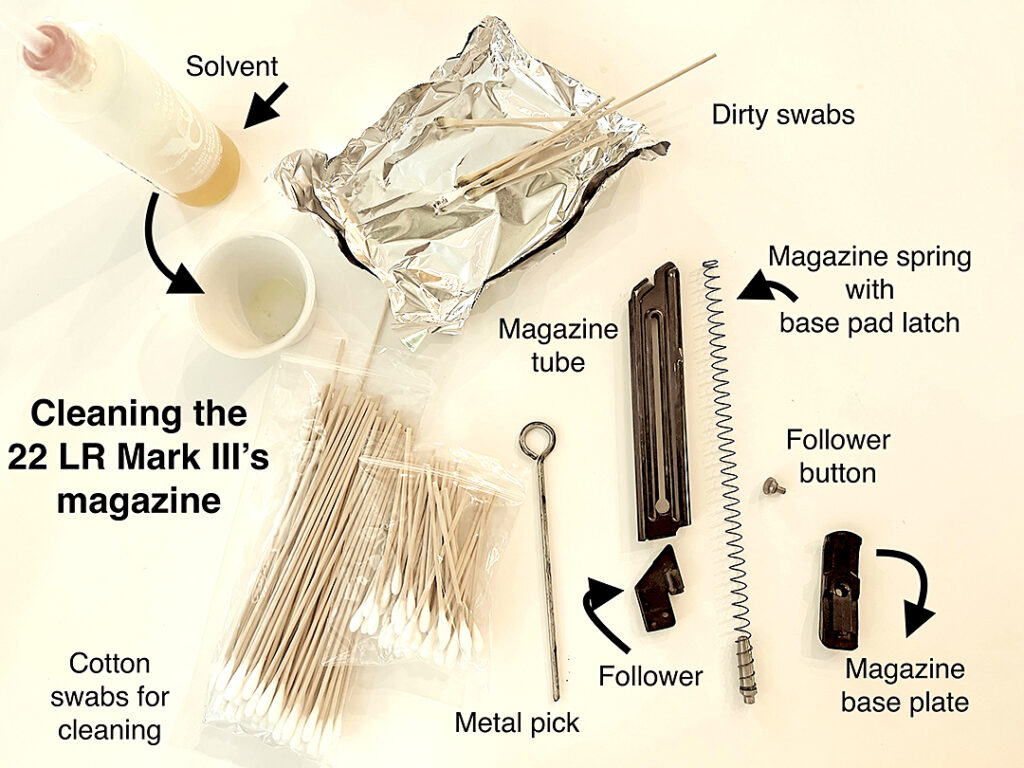Cleaning the Ruger Mark III or IV magazines


I hadn’t shot the Ruger Mark III in, well, maybe a couple years. It’s a .22-caliber handgun; great for newbie users. The actual bullet size is .22 in diameter, but when we refer to the actual cartridge or gun, it’s a .22 or .22 LR.
The Mark III is excellent for training new gun users because shooting gives practically no recoil. The crack when fired is not terribly loud. When Newbie doesn’t have to worry about managing recoil or loud sounds, he/she can concentrate on shooting stance and grip.
Next week, Mary is coming to the range. Her husband has a 9mm Springfield Ronin. Since it has significantly more recoil than the .22, we’ll start Mary on the .22 and work our way up to the 9.
At home, I drop the magazine and peer into the ejection port and chamber. Yay! Before I had put it away, I had cleaned it! That’s what we ought to do, but do we always do it? Ahem. So, it’s all clean and ready for a trip to the range.
Since I hadn’t shot this gun in quite some time, Joe and I went to the Wakulla County Sheriff’s Office range to get the feel of it all over again.
The range is “hot.” I take the Mark III out of its pouch, and then the magazine. I slide 10 rounds in the magazine with no problem.
I’m in my favorite stance, breathe, aim, and squeeze that trigger.
Pop!
Right near the center of the target. Easy!
Squeeze again. Click! Wait, what happened? Stovepipe! The round is sitting straight up in the chamber! That’s not right! I dump the magazine and pull back the bolt to release the round.
Back in goes the magazine. This time, I hear a satisfying pop as the bullet flies to the target. Ah, yes. Smooth and easy.
I squeeze the trigger again. Click! What? This time, the round is stuck at the bottom of the ramp.
Joe has been watching.
“That’s a .22, and they’re so bad about cleaning,” he says. “Did you clean your gun?”
Huh. Well, sometimes I’m not so great about it, but this time, I knew it was pristine.
“Of course the gun is clean. Want to see?”
I hand him the gun, keeping the muzzle pointing down range.
He locks back the bolt and inspects the chamber and port.
“Yes, it’s amazingly clean. Especially for a .22!”
He’s a little surprised.
OK, I’m only a tiny bit insulted.
When something goes wrong, it’s often shooter error. But this time, I’ve got a clean .22, it’s a great gun, and it’s easy to shoot.
I have an idea. I pull out a different magazine and load 10 rounds. Pop! Pop! Pop!
All rounds fire perfectly.
“Marj, you cleaned your gun,” Joe begins, “but did you clean your magazine?”
Darn. These .22s are hard enough to clean. Now I have to clean the magazine too?
We return home, and Joe takes out that first magazine. He pulls down the loading button and shows me the inside of the top. You’d think someone put clay or hard mud in it.
Looks like we have to clean magazines as well. Especially .22s, which collect a lot of shooting residue inside the gun.
Yes, to clean this thing, Joe says we have to take it apart. Sigh.
Look at the bottom of the magazine. See that hole with the silver color at the bottom?
Take a sturdy metal pick about the size of the hole. Hold both hands over the bottom of the magazine, because you’re about to release a spring which could fly around the room if you’re not careful. Now, take your metal pick and push into the hole. You’ll feel the bottom piece of the magazine (the magazine base pad) loosen. Keeping your hands caged over this piece, take your thumb and slide it towards its longer side.
Off it comes and the spring pops partially out. Good thing you have it caged. Now, pull it all the way out of the mag. It sort of sticks at the end, but pull it all the way out. The spring has a metal magazine base pad latch on one end.
Next, bring the follower button down to the base of the magazine, where a larger hole allows it to come out. Last, the follower will slide out of the magazine tube.
Now you have the: magazine tube, follower, follower button, spring, base pad latch, and the base pad.
For cleaning: The top of the follower is pretty dirty, as is the inside top of the magazine. Take a long cotton swab with solvent and clean the inside of the magazine, paying close attention to the inside top. Taking a solvent-dipped rag, wipe down the outside of the mag, the follower, and the spring, as well. All clean!
Put it back together. Slide in the follower until its small hole lines up with the larger hole in the mag. Then, put the button in this opening. Now the button and the follower will slide upward. Install the spring carefully, as it may try to buckle.
Compress the spring to install the pad. Line up the base pad to slide onto the base of the magazine tube. Push it, short side first, until the magazine base pad lines up with the hole. You’ll feel a click as the base pad slides onto the magazine tube and aligns with that latch button.
This is all a bit of an effort.
“Why not just pull down on the follower button and take a Q-tip to swab out the first inch or so of the inside of the magazine, and the follower, too?” I ask Joe. “Isn’t this the dirtiest part of the mag?”
“That will work for a fairly long while, but you’ve had the Mark III for years. When did you clean its magazines last?”
Well, like: never?
“It has been a while,” I admit.
“Ah, huh,” he mutters under his breath.
Marj Law is the former director of Keep Wakulla County Beautiful who has become an avid shooter in retirement.


